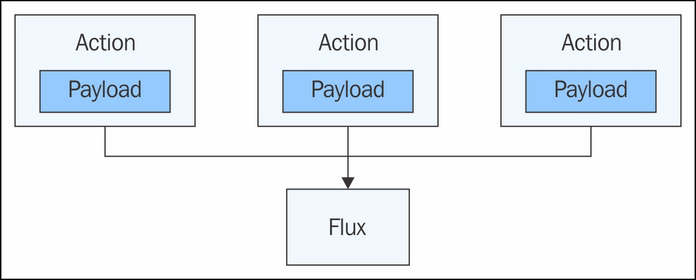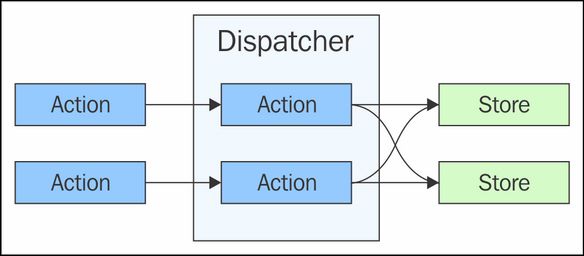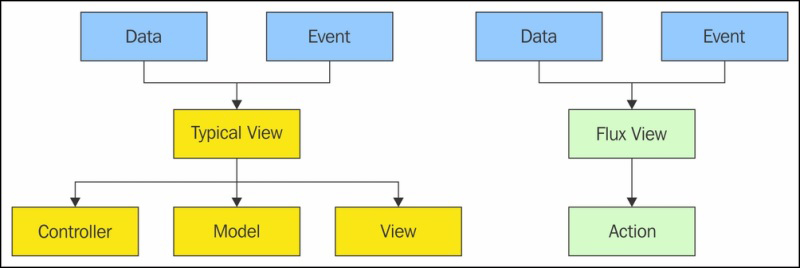In this section, we'll begin our journey into the concepts of Flux. These concepts are the essential ingredients used in formulating a Flux architecture. While there's no detailed specifications for how these components should be implemented, they nevertheless lay the foundation of our implementation. This is a high-level introduction to the components we'll be implementing throughout this book.
Actions are the verbs of the system. In fact, it's helpful if we derive the name of an action directly from a sentence. These sentences are typically statements of functionality – something we want the application to do. Here are some examples:
Fetch the session
Navigate to the settings page
Filter the user list
Toggle the visibility of the details section
These are simple capabilities of the application, and when we implement them as part of a Flux architecture, actions are the starting point. These human-readable action statements often require other new components elsewhere in the system, but the first step is always an action.
So, what exactly is a Flux action? At it's simplest, an action is nothing more than a string—a name that helps identify the purpose of the action. More typically, actions consist of a name and a payload. Don't worry about the payload specifics just yet—as far as actions are concerned, they're just opaque pieces of data being delivered into the system. Put differently, actions are like mail parcels. The entry point into our Flux system doesn't care about the internals of the parcel, only that they get to where they need to go. Here's an illustration of actions entering a Flux system:

This diagram might give the impression that actions are external to Flux, when in fact they're an integral part of the system. The reason this perspective is valuable is because it forces us to think about actions as the only means to deliver new data into the system.
The dispatcher in a Flux architecture is responsible for distributing actions to the store components (we'll talk about stores next). A dispatcher is actually kind of like a broker—if actions want to deliver new data to a store, they have to talk to the broker, so it can figure out the best way to deliver them. Think about a message broker in a system like RabbitMQ. It's the central hub where everything is sent before it's actually delivered. Here is a diagram depicting a Flux dispatcher receiving actions and dispatching them to stores:

The earlier section of this chapter—"simple architectural layers"—didn't have an explicit layer for dispatchers. That was intentional. In a Flux application, there's only one dispatcher. It can be thought of more as a pseudo layer than an explicit layer. We know the dispatcher is there, but it's not essential to this level of abstraction. What we're concerned about at an architectural level is making sure that when a given action is dispatched, we know that it's going to make it's way to every store in the system.
Having said that, the dispatcher's role is critical to how Flux works. It's the place where store callback functions are registered and it's how data dependencies are handled. Stores tell the dispatcher about other stores that it depends on, and it's up to the dispatcher to make sure these dependencies are properly handled.
Stores are where state is kept in a Flux application. Typically, this means the application data that's sent to the frontend from the API. However, Flux stores take this a step further and explicitly model the state of the entire application. If this sounds confusing or like a generally bad idea, don't worry—we'll clear this up as we make our way through subsequent chapters. For now, just know that stores are where state that matters can be found. Other Flux components don't have state—they have implicit state at the code level, but we're not interested in this, from an architectural point of view.
Actions are the delivery mechanism for new data entering the system. The term new data doesn't imply that we're simply appending it to some collection in a store. All data entering the system is new in the sense that it hasn't been dispatched as an action yet—it could in fact result in a store changing state. Let's look at a visualization of an action that results in a store changing state:

The key aspect of how stores change state is that there's no external logic that determines a state change should happen. It's the store, and only the store, that makes this decision and then carries out the state transformation. This is all tightly encapsulated within the store. This means that when we need to reason about particular information, we need not look any further than the stores. They're their own boss—they're self-employed.
The last Flux component we're going to look at in this section is the view, and it technically isn't even a part of Flux. At the same time, views are obviously a critical part of our application. Views are almost universally understood as the part of our architecture that's responsible for displaying data to the user—it's the last stop as data-flows through our information architecture. For example, in MVC architectures, views take model data and display it. In this sense, views in a Flux-based application aren't all that different from MVC views. Where they differ markedly is with regard to handling events. Let's take a look at the following diagram:

Here we can see the contrasting responsibilities of a Flux view, compared with a view component found in your typical MVC architecture. The two view types have similar types of data flowing into them—application data used to render the component and events (often user input). What's different between the two types of view is what flows out of them.
The typical view doesn't really have any constraints in how its event handler functions communicate with other components. For example, in response to a user clicking a button, the view could directly invoke behavior on a controller, change the state of a model, or it might query the state of another view. On the other hand, the Flux view can only dispatch new actions. This keeps our single entry point into the system intact and consistent with other mechanisms that want to change the state of our store data. In other words, an API response updates state in the exact same way as a user clicking a button does.
Given that views should be restricted in terms of how data-flows out of them (besides DOM updates) in a Flux architecture, you would think that views should be an actual Flux component. This would make sense insofar as making actions the only possible option for views. However, there's also no reason we can't enforce this now, with the benefit being that Flux remains entirely focused on creating information architectures.
Keep in mind, however, that Flux is still in it's infancy. There's no doubt going to be external influences as more people start adopting Flux. Maybe Flux will have something to say about views in the future. Until then, views exist outside of Flux but are constrained by the unidirectional nature of Flux.



